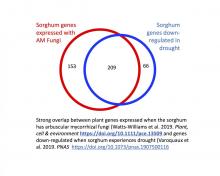Sorghum (Sorghum bicolor) is a grass closely related to sugarcane (Saccharum) and corn (Zea mays). It is the fifth most important cereal crop, globally and its use is increasing due to its ability to resist drought. We are studying the role that fungi play in sorghum’s drought resistance and initiated our studies with the obligately mutualistic mycorrhizal fungi found in sorghum roots, arbuscular mycorrhizal fungi (AM fungi). These fungi bring phosphorous and water to the plant, and for this service the plant pays them ca. 20% of the sugar and fats that it makes from photosynthesis. When sorghum has AM fungi, it turns on hundreds of genes that are silent without the fungi. We found that AM fungi show a remarkably strong succession over the four months that sorghum takes to go from germination to seed maturation (Gao, et al. 2019). When plants experience drought before flowering, the largest, strongest, concerted change in plant gene expression encompasses those hundreds of genes that sorghum uses to manage AM fungi (Varaquoux, et al. 2019). We think that the plant quits paying the AM fungi for phosphorous that it cannot use. When water returns, the expression of the genes returns to normal and, remarkably, so does the abundance of the same species of AM fungi that were in the roots prior to drought. We have also examined the community of all fungi, finding that root and leaf communities assemble by chance in the first few weeks of growth, but they fall under selection by the plant to arrive at their mature composition (Gao, et al. in press). We, now, are working with colleagues who have examined the role of bacteria in sorghum growth (Ling, et al. 2018) to see how fungi interact with these other microbes.
Publications on Sorghum and Fungi
- Gao, Cheng, Liliam Montoya, Ling Xu, Mary Madera, Joy Hollingsworth, Elizabeth Purdom, Vasanth Singan, John Vogel, Robert B. Hutmacher, Jeffery A. Dahlberg, Devin Coleman-Derr, Peggy G. Lemaux, John W. Taylor. 2020. Fungal community assembly in drought stressed sorghum shows stochasticity, selection, and universal ecological dynamics. Nature Communications 11:1-14. https://doi.org/10.1038/s41467-019-13913-9
- Nelle Varoquaux, Benjamin Cole, Cheng Gao, Grady Pierroz, Christopher R. Baker, Dhruv Patel, Mary Madera, Tim Jeffers, Joy Hollingsworth, Julie Sievert, Yuko Yoshinaga, Judith A. Owiti, Vasanth R. Singan, Stephanie DeGraaf, Ling Xu, Matthew J. Blow, Maria J. Harrison, Axel Visel, Christer Jansson, Krishna K. Niyogi, Robert Hutmacher, Devin Coleman-Derr, Ronan C. O'Malley, John W. Taylor, Jeffery Dahlberg, John P. Vogel, Peggy G. Lemaux, and Elizabeth Purdom. 2019. Transcriptomic analysis of field-droughted sorghum from seedling to maturity reveals biotic and metabolic responses. Proc Natl Acad Sci USA first published December 5, 2019. https://doi.org/10.1073/pnas.1907500116
- Gao, C., Montoya, L., Xu, L., Madera, M., Hollingsworth, J., Purdom, E., Hutmacher, R.B., Dahlberg, J.A., Coleman-Derr, D. Lemaux, P.G. and Taylor, J.W., 2019. Strong succession in arbuscular mycorrhizal fungal communities. The ISME journal, 13:214-226. https://doi.org/10.1038/s41396-018-0264-0
- Ling Xu, Dan Naylor, Zhaobin Dong, Tuesday Simmons, Grady Pierroz, Kim K. Hixson, Young-Mo Kim, Erika M. Zink, Kristin M. Engbrecht, Yi Wang, Cheng Gao, Stephanie DeGraaf, Mary A. Madera, Julie A. Sievert, Joy Hollingsworth, Devon Birdseye, Henrik V. Scheller, Robert Hutmacher, Jeffery Dahlberg, Christer Jansson, John W. Taylor, Peggy G. Lemaux, and Devin Coleman-Derr (2018). Drough delays development of the sorghum root microbiome and enriches for monoderm bacteria. Proceedigns of the National Academy of Sciences, 115(18), E4284-E4293. https://doi.org/10.1073/pnas.1717308115

